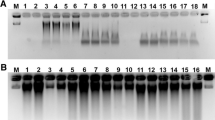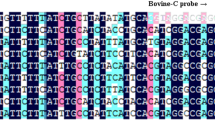Abstract
The identification of species presents in food is important due to many reasons. Some of them are economic fraud and/or sanitary problems, which could arise from inaccurate identifications of the composition of food products. Adulteration of processed meat generally occurs when there is a considerable price differential between raw materials from different species. Also, it occurs too when trying to introduce raw material of dubious origin, or even raw materials prohibited in some countries for cultural reasons. For example, dog traces were discovered in pet food in Spain in early 2013. This work describes development and validation of two real-time PCR methods, one for dog detection and other one for cat in foodstuffs. The method is based on specific primers/TaqMan probe sets that amplify a fragment of the Cytochrome oxidase subunit I sequences. TaqMan probes allow rapid and accurate assessment of even very small quantities of contaminants, even in thermally treated products. The detection limit was 2 and 0.2 pg of the target DNA from dog and cat, respectively. The methodology was validated to check how the degree of food processing affects the applicability of this technique. Additionally, a total of 100 samples from pet food, farm animal products and raw material were analyzed to apply the developed methodology to commercial samples. Possible applications of these methods are as process control, food security, traceability verification in commercial trade and the correct application of food labelling regulations. In conclusion, the real-time PCR methodology described herein represents a useful tool for the detection of dog and cat traces in all kind of products, including processed products that have undergone aggressive treatments (canned meals and feeds).

Similar content being viewed by others
References
(EU) CR No 1069/2009 of the European Parliament and of the Council of 21 October 2009 laying down health rules as regards animal by-products and derived products not intended for human consumption and repealing Regulation (EC) No 1774/2002 (Animal by-products Regulation)
Martín I, García T, Fajardo V, Rojas M, Hernández PE, González I, Martín R (2007) Detection of cat, dog, and rat or mouse tissues in food and animal feed using species-specific polymerase chain reaction. J Anim Sci 85(10):2734–2739
Aranguren-Méndez J, Portillo M, Ruiz J, Villasmil-Ontiveros Y, Yáñez L, Borjas L, Zabala W (2009) Identificación de especies en productos de origen animal mediante PCR Revista Científica 19(2):159–164
Gao HW, Xu BL, Liang CZ, Zhang YB, Zhu LH (2004) Polymerase chain reaction method to detect canis materials by amplification of species-specific DNA fragment. J AOAC Int 87(5):1195–1199
Cao W, Hashibe M, Rao JY, Morgenstern H, Zhang ZF (2003) Comparison of methods for DNA extraction from paraffin-embedded tissues and buccal cells. Cancer Detect Prev 27(5):397–404
Feigelson HS, Rodriguez C, Robertson AS, Jacobs EJ, Calle EE, Reid YA, Thun MJ (2001) Determinants of DNA yield and quality from buccal cell samples collected with mouthwash. Cancer Epidemiol Biomarkers Prev 10:1005–1008
Lago FC, Herrero B, Madriñán M, Vieites JM, Espiñeira M (2011) Authentication of species in meat products by genetic techniques. Eur Food Res Technol 232(3):509–515
Winfrey MR, Rott MA, Wortman AT (1997) Unraveling DNA: molecular biology for the laboratory. Prentice Hall, New York
Thompson JD, Gibson TJ, Plewniak F, Jeanmougin F, Higgins DG (1997) The CLUSTAL_X windows interface: flexible strategies for multiple sequence alignment aided by quality analysis tools. Nucl Acids Res 25(24):4876–4882
Hall TA (1999) BioEdit: a user-friendly biological sequence alignment editor and analysis program for Windows 95/98/NT. Nucleic Acids Symp Ser 41:95–98
Murray GI, Curran S (2005) Laser capture microdissection: methods and protocols, vol 293. Humana Press Totowa, NJ
Herrero B, Royo LJ, Lago FC, Vieites JM, Espiñeira M (2013) Authentication of male beef by multiplex fast real-time PCR. Food Addit Contam Part A 30(2):218–225
Espiñeira M, Gonzalez-Lavin N, Vieites JM, Santaclara FJ (2008) Development of a method for the genetic identification of flatfish species on the basis of mitochondrial DNA sequences. J Agric Food Chem 56(19):8954–8961
Espiñeira M, Gonzalez-Lavin N, Vieites JM, Santaclara FJ (2009) Development of a method for the identification of scombroid and common substitute species in seafood products by FINS. Food Chem 117(4):698–704
Espiñeira M, Vieites JM (2012) Authentication of the most important species of rockfish by means of FINS. Eur Food Res Technol. doi:10.1007/s00217-012-1824-6
Espiñeira M, Vieites JM, Santaclara FJ (2009) Development of a genetic method for the identification of salmon, trout, and bream in seafood products by means of PCR-RFLP and FINS methodologies. Eur Food Res Technol 229(5):785–793
Herrero B, Lago FC, Vieites JM, Espiñeira M (2011) Authentication of swordfish (Xiphias gladius) by RT-PCR and FINS methodologies. Eur Food Res Technol 233(2):195–202
Herrero B, Lago FC, Vieites JM, Espiñeira M (2012) Real-time PCR method applied to seafood products for authentication of European sole (Solea solea) and differentiation of common substitute species. Food Addit Contam 29(1):12–18
Herrero B, Madriñan M, Vieites JM, Espiñeira M (2010) Authentication of Atlantic Cod (Gadus morhua) Using Real Time PCR. J Agric Food Chem 58(8):4794–4799
Herrero B, Vieites JM, Espiñeira M (2011) Authentication of Atlantic salmon (Salmo salar) using real-time PCR. Food Chem 127(3):1268–1272
Herrero B, Vieites JM, Espiñeira M (2011) Duplex real-time PCR for authentication of anglerfish species. Eur Food Res Technol 233:817–823
Lago FC, Herrero B, Vieites JM, Espiñeira M (2011) FINS methodology to identification of sardines and related species in canned products and detection of mixture by means of SNP analysis systems. Eur Food Res Technol 232(6):1077–1086
Lago FC, Herrero B, Vieites JM, Espiñeira M (2011) Genetic identification of horse mackerel and related species in seafood products by means of forensically informative nucleotide sequencing methodology. J Agric Food Chem 59(6):2223–2228
Lago FC, Vieites JM, Espiñeira M (2011) Development of a FINS-based method for the identification of skates species of commercial interest. Food Control 24:38–43
Espiñeira M, Herrero B, Vieites JM, Santaclara FJ (2010) Validation of end-point and real-time PCR methods for the rapid detection of soy allergen in processed products. Food Addit Contam 27(4):426–432
Pfaffl MW (2004) Quantification strategies in real-time PCR. AZ Quant PCR 1:89–113
EURL. European Union Reference Laboratory. http://eurl.craw.eu/en/187/method-of-reference-and-sops
EU 63/2010 (2010) Official Journal of the European Union Directive 2010/63/EU of the European Parliament and of the Council of 22 September 2010 on the protection of animals used for scientific purposes
Cheng TH, Chen SP, Lu TC, Chen WC, Sher JS, Shieh YS (2010) Optimal DNA extraction from buccal swab samples. J Med Sci 30(4):149–154
Herrero B, Lago FC, Vieites JM, Espiñeira M (2012) Rapid method for controlling the correct labeling of products containing European squid (Loligo vulgaris) by fast real-time PCR. Eur Food Res Technol 234(1):77–85
Acknowledgments
We thank Fátima C. Lago and Mercedes Alonso for their helpful assistance. We wish to acknowledge the support of Luis J. Royo (Department of Animal Nutrition, Grassland and Forages, SÉRIDA, Spain) for providing some of the samples included in this work.
Conflict of interest
None.
Compliance with Ethics Requirements
This article does not contain any studies with human or animal subjects.
Author information
Authors and Affiliations
Corresponding author
Rights and permissions
About this article
Cite this article
Espiñeira, M., Vieites, J.M. Detection of dog and cat traces in food, pet food and farm animal feed by real-time PCR. Eur Food Res Technol 241, 233–238 (2015). https://doi.org/10.1007/s00217-015-2448-4
Received:
Revised:
Accepted:
Published:
Issue Date:
DOI: https://doi.org/10.1007/s00217-015-2448-4




